
Scope selection for this Winchester Model 70 Super Grade was not casual. The 270 WSM is a very flat shooting, hard hitting long range cartridge so a proper scope is required to extract its potential. Mounted on this hunting rifle, the selected scope needs to survive extreme heat and cold, recoil, rain and other forms of inclement weather without losing zero, taking on water or fogging.
As a matter of firearm aesthetics and pride of ownership, it is bad form to have a high power rifle, with all of this fancy wood and hardware, blemished by the presence of a cheap scope; hanging the Mona Lisa in an outhouse. Accordingly, the Winchester was matched up with a very nice Leupold VX®-6 2-12x42mm CDS, matte finish and FireDot Long Range reticle. #111980.
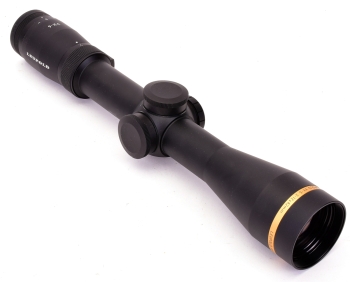
I am a scope sharer; fewer but better scopes moved about a population of firearms. Subsequently, the VX-6 was installed with Leupold QR bases and rings. Tough steel parts, high grade hardware with locking compound and no rough edges to scratch nice scope finishes.
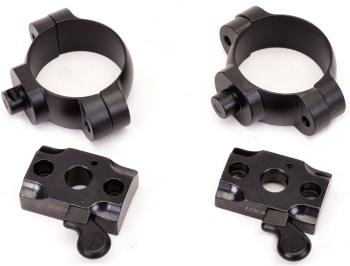
The fit between these parts is so precise that the ring stubs won’t drop into the bases until the bases have been tightened to a firearm’s receiver. Installation was kind of a treat. The bases and lower ring halves went on. The scope plopped right into place in the lower ring saddles and the rings went on leaving just enough gap to assure the scope was secured. All hardware was light oiled and torqued to 28 in/lbs as specified by Leupold.
It is probably because I mount four or five scopes each week that I can still be enthusiastic about something as basic as scope rings and bases and there clearly is a difference in quality of parts from one manufacturer to another. It is very disappointing to drop $50 on rings, only to find they have to be forced over a scope tube or burrs cut into a $1,200 scope, or they are so poorly made that offset bushings and shims are needed to zero a rifle. In this case, 2 clicks left and one click down aligned the cross hairs on the boresight grid, leaving the scope settings at just about neutral adjustment.

Live fire performance…
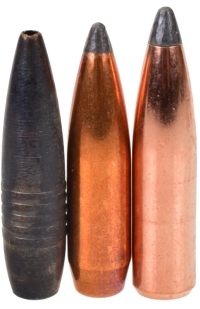
We’ve covered handloads for the 270 WSM on numerous occasions on Real Guns across a wide variety of bullet weights. The first time was shortly after the round’s introduction and with a then newly introduced Winchester Super Shadow. This time the bullet selection was narrowed to three.
| Manufacturer | Bullet | Type | Weight Grains |
Length Inches |
BC | COL Inches |
| GS Custom | HV | HPBT | 110 | 1.174″ | 0.375 | 2.735 |
| Sierra | GameKing | SPBT | 140 | 1.188″ | 0.457 | 2.785 |
| Nosler | Partition | SP | 250 | 1.255″ | 0.465 | 2.850 |
|
Length dimensions actual |
||||||
The GS Custom is a little different than a Barnes TSSX bullet. The shank is bore diameter, the driving bands are groove diameter. As a result, bore friction and start pressure are dramatically reduced and muzzle velocity are typically higher than other bullet construction types.
The downsides to these machine turned copper alloy bullets is that low sectional density leads to a low ballistic coefficient and 0.277″ bullets heavier than 110 grains requires an 1:8″ twist, something not found in production 270 WSM or 270 Winchester… or 270 Weatherby, or 6.8 SPC. Seems as though the folks at GS Custom designed a bullet with interesting specs, but forgot to see if there was an accommodating firearm. In any event, the 110 grain works fine with a 1:10″ twist and is launched at approximately 3700 fps with a point blank range of 348 yards on a +3 ordinate. The bullet leaves the muzzle of a rifle with 3,300+ ft/lbs of kinetic energy and retains 1,000 ft/lbs + out to just under 700 yards.
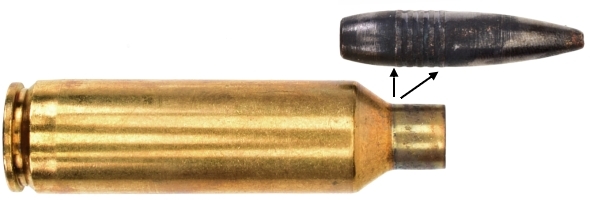
A last note on the GS Custom regarding seating depth. You may have noted in the preceding table that the GS Custom bullet assemblies have the shortest cartridge overall length. The reason can be found in the bullet shank, which is 0.270″ and the driving bands which are 0.277″. The group of driving bands needs to reside in the cartridge’s neck as these are the only surface to react to neck tension.
 There is a passage on the GS Custom site regarding crimping… don’t, suggesting that neck tension alone is required. Evidence is presented as tension so tight that a bullet’s driving band pattern appears in the brass. I have not seen this phenomena resulting with three different sizer dies and respective manufacturer, even with soft Norma brass. Typically, a 270 WSM sizer die reduces neck inside diameter to 0.264″, a 0.276″ expander is pulled back through the neck, then the brass springs back to a case neck inside diameter of 0.274″. Neck tension cause by 0.003″ of dimensional interference secures the bullet.
There is a passage on the GS Custom site regarding crimping… don’t, suggesting that neck tension alone is required. Evidence is presented as tension so tight that a bullet’s driving band pattern appears in the brass. I have not seen this phenomena resulting with three different sizer dies and respective manufacturer, even with soft Norma brass. Typically, a 270 WSM sizer die reduces neck inside diameter to 0.264″, a 0.276″ expander is pulled back through the neck, then the brass springs back to a case neck inside diameter of 0.274″. Neck tension cause by 0.003″ of dimensional interference secures the bullet.
The Sierra bullet has a good BC, controlled expansion and is sold at a realistic price. Launched at 3,200 fps, point blank range is 314 yards on a 3″+ ordinate. Muzzle energy is 3,400, 1,000 ft/lbs at 700 yards. Experience has shown this bullet to be highly accurate, expanding reliably over a wide velocity range.
The Nosler Partition is a tough bullet with a nose that expands relatively quickly and a shank that holds together and does not. The result is a penetrating bullet that opens a large wound channel. While some Partitions aren’t particularly streamlined, this caliber is with a 306 yard point blank range and it retains over half ton of energy out to nearly 800 yards.
Handloads fed to the Winchester Model 70 Super Grade 270 WSM
 |
Warning: Bullet selections are specific, and loads are not valid with substitutions of different bullets of the same weight. Variations in bullet material and length will alter net case capacity, pressure and velocity results. Primer selection is specific and primer types are not interchangeable. These data represents maximum loads in our firearms and test equipment and may easily be excessive in other applications. All loads should be reduced by 3%, and developed following safe handloading practices as represented in established reloading manuals produced by component manufacturers. Presentation of these loads does not constitute a solicitation for their use, nor a recommendation.
|
||||||||||||||||||||||||||||||||||||||||||||||||||||||||||||||||||||||||||||||||||||||||||||||||||||||||||||||||||||||||||||||||||||
|
|||||||||||||||||||||||||||||||||||||||||||||||||||||||||||||||||||||||||||||||||||||||||||||||||||||||||||||||||||||||||||||||||||||
The data was gathered from a new rifle; clean patch through the bore, 27 rounds down the barrel to get average velocity readings for each load. 27 more rounds were shot to get group size. No break in, no elaborate cleaning routines and 10ºF weather to help keep the barrel cool between each change over. Another 50 rounds and velocity would probably increased a bit and I would have put on some more layers of clothing to take the shivering factor out of group sizes… based on the degree of teeth chattering to correspond with the shivering, at least 0.1″ tighter groups.
The stock was very comfortable standing and shooting or leaning forward at the bench. The comb height provides good eye – scope alignment and it didn’t thump against my cheekbone under recoil. The rifle’s balance felt neutral when shooting from a standing position and the well padded recoil pad dampened the thump and provided a good deal of lateral stability. The checkering LPI worked well; good non-slip surface even with cold hands on cold wood and no cheese grating under recoil. Nice.
Shooting the 270 WSM is a bit different than shooting a standard 270 Winchester. Recoil is slightly higher. Muzzle pressures are similar, but the 270 WSM has a sharper report. The WSM exceeds the 270 Winchester velocity by 100 – 125 fps dependant upon bullet weight for a 323 yard versus 312 yard point blank range on a +3″ ordinate result. Is that enough gain for someone to turn in a good shooting 270 Winchester for a WSM upgrade? Probably not, but for someone shopping for a new rifle, the 270 WSM provides an alternative to the 270 Winchester. From another perspective, a very pretty Super Grade 270 WSM can deliver the performance of a 270 Weatherby Magnum at approximately 60% the cost of the Weatherby.
Before I move on to other things…
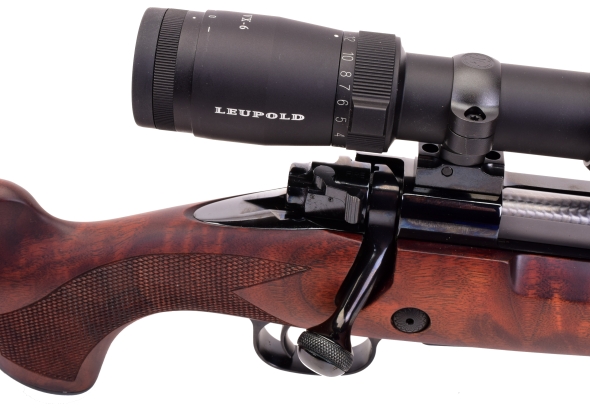
The intent was not to assess the effectiveness of the 270 WSM, but rather to provide insight into the Winchester Model 70 Super Grade’s performance. As noted in Part 1 of this series, the Super Grade is available in: 243 Win, 7mm-08 Rem, 308 Win, 270 Win, 30-06 Spfld, 270 WSM, 7mm Rem Mag, 300 WSM, 300 Win Mag, and 338 Win Mag. The quality aesthetics, accuracy and reliability come with the rifle, regardless the chamber selected.

Email Notification